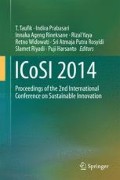Abstract
Founded in 2007, Serang was considered as one of the new cities in Indonesia. That was why vegetables commodities mapping was not available yet. This mapping was essential for a new city to create an accurate policy in order to develop and maintain sustainable agriculture practices. Many agriculture commodities mappings were constructed by using location quotient (LQ) method. Unfortunately, it was based on productivity only. In this paper, we presented a vegetables commodities mapping by using not only production factor, but also farmer’s socioeconomic indicators, namely: (1) land width (preservation), (2) future land width (enhancement), and (3) household expenditure. The production factors and the farmer’s socioeconomic indicators were mapped and drawn in a biplot as the first and the second layer. These two layers were overlayed in order to obtain a priority commodity in each district. Finally, this study resulted in four commodity priority categories, and they are: first, Cipocok Jaya district as the main priority with cucumber as its potential commodity; second, Curug district with chili as its commodity; third, Walantaka district with chili and Taktakan district with pea bean as their potential commodities; and finally, Kasemen and Serang districts that have no identified commodity yet.
Access this chapter
Tax calculation will be finalised at checkout
Purchases are for personal use only
References
Peljor, N, and N Minot. 2010. Food security and food self-sufficiency in Bhutan. International Food Policy and Research Institute: Washington.
RPJM Banten. 2010. Banten Province: the first draft.
Dinas Pertanian Kota Serang. 2013. Pemanfaatan Lahan Pertanian bagi Kebijakan Pemerintah Daerah. Presented in BPS 2013 Agriculture Census Presentation: 26 March 2013 in Serang.
Zakaria, Amin. 2003. Decentralization Extensions to Local Government: Indonesia Experience. Regional Workshop on Operational zing Reform in Agricultural Extension in South Asia, New Delhi May 6 – 8 2003.
Bryan, A A, S Hajkowicz, S Marvanek, and M D Young. Mapping Economic Returns to Agriculture for Informing Environment Policy in the Murray – Darling Basin Australia. Environmental Modelling and Assessment Vol. 14 Issue 3, pp 375 – 390.
Amaliah I and Julia A. 2012. Pemetaan Faktor Penentu Daya Saing Komoditas Hortikultura Unggulan di Jawa Barat. Prosiding Seminar Nasional Penelitian dan PKM: Sosial, Ekonomi, dan Humaniora pp: 225 – 231.
Yulianti M. 2011. Penentuan Prioritas Komoditas Unggulan Buah-buahan di Kabupaten Minahasa Utara Provinsi Sulawesi Utara: Aplikasi Analsisi LQ dan Daya Tarik – Daya Saing. Jurnal Agribisnis Perdesaan Vol. 01 No. 03 pp: 206 – 221.
Isard, W, K Basset, C Choguill, J Furtado, R Izumita, J Kissin, E Romanoff, R Seyfarth, and R Tatlock. 1968. On the Linkage of Socio-Economic and Ecological System. Journal of the Regional Science Association International Vol 21. Issue 1, pp 79–99.
Chiang, Shu-hen. 2009. Location Quotient and Trade. Ann Reg Sci Vol. 43, pp 399 – 414.
Mack, RS, and DS Jacobson. 1996. Core Periphery Analysis of the European Union: a Location Quotient Approach. The Journal of Regional Analysis and Policy Vol. 26 No. 1, pp 3 – 21.
Ismayani. 2013. Development Strategy of Prime Commodities of Plantation in the District of Aceh Besar. Developing Countries Studies Vol. 3, No. 7, pp 1 – 11.
Suliyanto, -, and D Purnomojati. 2012. Analysis of Determining Basis Commodity and Pricing at Basis Commodity in Banyumas Indonesia. Interdisciplinary Journal of Research in Business Vol. 2 Issue. 2 pp, 27–36.
Bakhtiari, S, and M Dehghani zadeh. 2012. Proposing a New Version of Location Quotients for Estimating Regional Input-Output Coefficients: A Case Study of Iran’s Yazd Province. African Journal of Business Management Vol. 6 Issue. 23, pp 6903 – 6909.
Kiser, Don. 1992. A Location Quotient and Shift Share Analysis of Regional Economies in Texas [Thesis]. Southwest Texas State University: Texas.
Syafruddin, Kairupan AN, Negara A, and Limbongan J. 2004. Penataan Sistem Pertanian dan Penetapan Komoditas Unggulan Berdasarkan Zona Agroekologi di Sulawesi Tengah. Jurnal Litbang Pertanian Vol. 23 No. 2 pp: 61 – 67.
BPS (Badan Pusat Statistik). 2013. Kota Serang dalam Angka 2012.
Hutchinson, SR, and CD Lovell. 2004. A Review of Methodological Characteristics of Research Published in Key Journals in Higher Education: Implications for Graduate Research Training. Research in Higher Education Vol. 45 No. 4, pp 383 – 403.
Scheafer, Richard L, Mendenhall W, and Ott L. 1990. Elementary Survey Sampling. PWS – Kent Publising: Boston.
BPS (Badan Pusat Statistik). 2012. Kota Serang dalam Angka 2011.
Hardle W and Simar L. 2007. Applied Multivariate Statistical Analysis. Springer-Verlag: Berlin.
Author information
Authors and Affiliations
Corresponding author
Editor information
Editors and Affiliations
Rights and permissions
Copyright information
© 2017 Springer Science+Business Media Singapore
About this paper
Cite this paper
Budiaji, W., Pancawati, J., Suherna (2017). Vegetables Mapping Using Production and Socioeconomic Indicators Approach. In: Taufik, T., et al. ICoSI 2014. Springer, Singapore. https://doi.org/10.1007/978-981-287-661-4_13
Download citation
DOI: https://doi.org/10.1007/978-981-287-661-4_13
Published:
Publisher Name: Springer, Singapore
Print ISBN: 978-981-287-660-7
Online ISBN: 978-981-287-661-4
eBook Packages: Earth and Environmental ScienceEarth and Environmental Science (R0)

